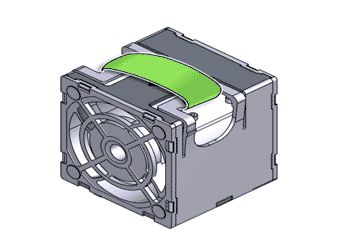If a fan module fails, the system issues critical alerts. Replace failed fan modules as soon as possible.
- Prerequisites:
Ensure that you have a Phillips Number 2 screwdriver with at least a 4-inch shaft.
Before handling a component, touch a grounded surface to discharge any static electricity.
Attach an electrostatic discharge (ESD) wrist strap to your wrist, and stand on an ESD mat while replacing components.
Deploy any rack anti-tilt mechanism before releasing the release buttons and extending the Replication Engine chassis.
Each Replication Engine has five fan modules that are located side-by-side at the center inside the Replication Engine chassis. A fan module is a customer replaceable unit (CRU). Replacing a fan module requires you to bring the Replication Engine offline. The following figure shows a Replication Engine fan module.


Figure 1: Fan module

Figure 2: Fan module location

- Legend
1 Fan module-0 2 Fan module-1 3 Fan module-2 4 Fan module-3 5 Fan module-4
Note: The fan modules can be accessed only after removing the top cover over the Replication Engine chassis.
Note: To replace a fan module, you do not need to remove the Replication Engine from the rack but extend it along the Replication Engine rails using the cable management arm (CMA).
Note: Ensure that all power is removed from the Replication Engine before replacing the fan module. Disconnect the power cables before performing the fan module replacement procedure.
Note: For fan replacement, the Replaceable Unit list displays the names of each fan. Each power supply contains one fan, and each fan module contains two fans. If a fan fails in a power supply, replace the power supply. If a fan fails in a fan module, replace the fan module. The following list identifies the names of the fans and the corresponding customer replaceable unit (CRU).
- If the following fan fails
- Replace the following CRU
- Fan 0
- Power supply 0
- Fan 1
- Power supply 1
- Fans 2, 3
- Fan module 0
- Fans 4, 5
- Fan module 1
- Fans 6, 7
- Fan module 2
- Fans 8, 9
- Fan module 3
- Fans 10, 11
- Fan module 4